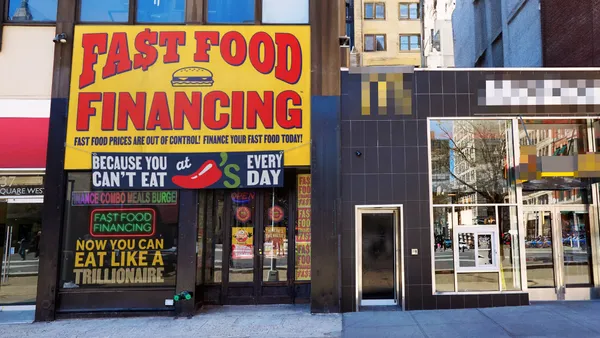Dive Brief:
- Starbucks unveiled a new kitchen layout and equipment designed to speed up drink production and reduce the physical intensity of barista work at its Investor Day on Tuesday.
- The new format and operations, called the Siren System, switches up the layout of Starbucks’ drink production by eliminating the need for workers to open refrigerators while making cold drinks.
- Starbucks leaders, against the backdrop of a union drive and complaints about the chain’s treatment of union workers, focused heavily on how operational efficiency improvements and store design would impact staff.
Dive Insight:
John Culver, the company’s outgoing chief operating officer, introduced the Siren System as a way to speed up drink production and simplify operations while improving employee experiences. It is currently being market tested in an unspecified number of cafes, with plans for a full rollout of the system coming in fiscal years 2024 and 2025.
With the new system, the chain appears to be torn between two goals: catering to diner demand for highly customized digital orders and taking pressure off of employees.
Brady Brewer, Starbucks’ chief marketing officer, touted Starbucks’ comparative advantage provided by extensive customization, which accounts for $1 billion in annual U.S. sales. Brewer acknowledged, however, that this customer behavior can strain labor.
“When I go to the drive-thru with my three teenagers, I have to try and calm their menu items down because I feel bad for the person who has to make it,” Brewer said. “The customization is what customers want.”
A number of Starbucks workers interviewed by Restaurant Dive have said mobile orders, TikTok recipes and hyper-customized drinks have piled a new layer of stress on an already difficult job.
During a live a demonstration conducted during Culver’s presentation, one worker made a mocha frappuccino on the company’s old makeline, which requires baristas to scoop ice and retrieve ingredients from a refrigerator. The drink took about 83 seconds to make. A second worker made the same drink using the Siren System, which dispenses ice and some ingredients from a machine above the line, in about 35 seconds.
While a single test conducted by two employees isn’t a scientific assessment of efficiency, the workers said the Siren System makes their jobs physically easier. The ice dispenser eliminates the need to haul heavy buckets of ice from the back of house to the bar, for example.
“There's no bending, there's less turning. And usually after a long day of doing all of those movements, I'm pretty exhausted,” the worker said.
The Siren System will also include a new method for brewing hot coffee and faster food warming, according to Culver. Next year, in a separate investment, Starbucks will put $450 million toward modernizing stores, focusing on equipment intended to improve cafe functions.
Culver also addressed the ongoing union drive at Starbucks’ U.S. stores. That organizing has been fueled, in part, by worker discontent with the company’s current mobile ordering system. Workers have told Restaurant Dive that surges of highly customized mobile orders frequently overwhelm stores with orders that equipment and labor are unable to fill in a reasonable amount of time. It’s not clear if the Siren System or other equipment upgrades will be available in union stores.
Starbucks Workers United members, and allies from other unions, picketed the Investor Day.













